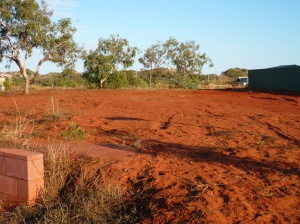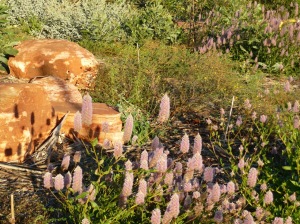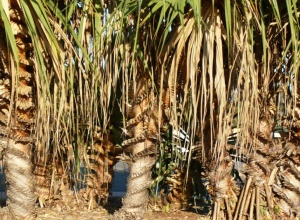In the beginning there was… a bare block of dirt

A bare patch of dirt can be a daunting but exciting prospect when you are planning a new garden or redesigning part of your yard. Where to start when you don’t have a team of television experts to blitz it for you?
Before you even pick up a spade, the best tools you can have at this stage is paper, pencil and eraser. List everything you want out of your space, such as; privacy, birds or wildlife or chooks, an area for the kids, the dog, room for the washing line, a pool or pond, the boat, rubbish bins, a vegetable patch and fruit trees, shade or sun, a shed, access to the back yard…etc.
Now think about other influences; where is north, and how much heat/light/shade will there be as the sun shifts during the year? Where might there be a sunny, snug spot for a cold season cuppa and where can you retreat to with a hammock, book and beverage in the heat of December?
Wet season rains can flood or scour so how can you slow that water down or harvest it in swales, and can you take advantage of the dry season dews dripping off the roof? Are there strong dusty winds at certain times of the year or cooling sea breezes you want to catch? Is there a view you want to see or screen?
Plan where pathways need to go and whether you need to dig reticulation underneath prior. And don’t forget to make a service path wide enough for a wheelbarrow, at the least!
This sort of planning and thinking gives you a better understanding of the needs and constraints of your yard, and will help you get the most out of your space. Whenever it seems a bit too daunting, recite the mantra “see solutions not problems”.

Planting your own Eden
Native plants offer an exciting range of flowers, foliage, colour, texture and beauty.
Don’t assume that by using natives you’re going to have an arid, desert like garden or a messy, dry one. You can achieve a gorgeous, resort-style space using Australian plants without following the trend of a “Balinese garden” or if you wanted a “cottage garden” there are stunning natives to create the same theme. You can also blend natives and exotics in the garden but consider their different water needs and general hardiness.

While many Australian species don’t need intensive care or vast amounts of water, they benefit in a garden situation from good maintenance; a light prune, timed reticulation especially while young, appropriate applications of native fertiliser, mulch, and perhaps importantly, right placement.
A prickly bush too close to where you park the car, or a tree that drops sticky sap over the washing line, or an innocuous bush that becomes a monster are all victims of wrong placement. And if you don’t feel the affects of it, your neighbours probably will.
Unfortunately you can’t always rely on plant labels to give you exact advice either; sometimes the information is too general, vague or not applicable to your growing conditions. Ask questions, talk to locals, hire an expert, read relevant books and observe what’s growing in your neck of the woods.

Few things are more rewarding for a gardener than actually planting out. Don’t plant one of everything though; it’s much better to plant en masse, going for groups of odd numbers. How good does a grove of silvery Grevillea look as opposed to two spaced several metres apart, or a swathe of tussock grass instead of three lonely clumps, a thicket of Acacia rather than just one. It is a common mistake to plant too few too far apart and the effect is miserable.
Think about using the wonderful range of coloured foliage like you would paint on a canvas. Silver groves can meld into green foliage, a bank of yellow and red flowers, a carpet of riotous wildflowers, or native grasses rippling like an ocean. Don’t be afraid to trim (or even topiary!) certain plants into balls or pillows, and give sculptural trees such as Spiral Pandanus or the Boab space around them to be enjoyed and a small floodlight to bring out their magnificent beauty at night.

Pathways are as much a part of garden design as the plants themselves and require careful thought. Winding paths can look enticing and enchanting – or may encourage people to cut cross-country. Pebble or rock paths and driveways are great to let water flow and seep rather than scour off a hard concrete surface – but may not be so marvellous for people with mobility problems or pushing a pram/sulo bin/wheelchair.

Height can be a marvellous foil in an otherwise flat yard. Use plants of different layers to give depth and perspective, or add a retaining wall and plant up. Avoid the tendency to dump a couple of cubic metres of soil in the middle because it not only looks like an out of place pimple on the landscape, but gravity will ensure your dirt and mulch slips away. Shape the dirt pile into lower, longer curves.

Finding natives to buy – especially those endemic to your area – may be a challenge. The Kimberley plant market is virtually untapped, with a few exceptions. It will improve if more people ask at their local nursery for indigenous plants, support those who are propagating them, and learn how to grow their own. Importantly though, we have to choose to plant natives instead of taking the easy, exotic, option for our gardens.
This short article merely scratches the surface of backyard design and it would be great to hear from you about your success, difficulties, ideas and solutions – with photos too.

Wonderful article, maybe it should be submitted to Broome Happenings for publication.